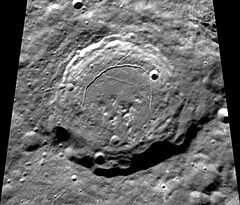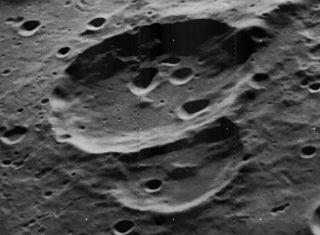 Clementine mosaic | |
| Coordinates | 72°41′N166°46′E / 72.69°N 166.76°E Coordinates: 72°41′N166°46′E / 72.69°N 166.76°E |
|---|---|
| Diameter | 91.4 km |
| Depth | Unknown |
| Colongitude | 163° at sunrise |
| Eponym | Alexander P. Karpinsky |


Karpinskiy is a lunar impact crater that lies in the northern part of the Moon on the far side from the Earth. This crater is concentric with a larger and older formation lying along the southern rim. This combined rim gives Karpinskiy a larger and wider interior wall along its south face. Just to the north is the double-crater formation of Milankovic and Ricco, which lies across the northern part of the large crater containing Karpinskiy. To the southeast of Karpinskiy is the smaller crater Schjellerup.

Lunar craters are impact craters on Earth's Moon. The Moon's surface has many craters, almost all of which were formed by impacts.

An impact crater is an approximately circular depression in the surface of a planet, moon, or other solid body in the Solar System or elsewhere, formed by the hypervelocity impact of a smaller body. In contrast to volcanic craters, which result from explosion or internal collapse, impact craters typically have raised rims and floors that are lower in elevation than the surrounding terrain. Impact craters range from small, simple, bowl-shaped depressions to large, complex, multi-ringed impact basins. Meteor Crater is a well-known example of a small impact crater on Earth.

Earth's Moon is an astronomical body that orbits the planet and acts as its only permanent natural satellite. It is the fifth-largest satellite in the Solar System, and the largest among planetary satellites relative to the size of the planet that it orbits. The Moon is, after Jupiter's satellite Io, the second-densest satellite in the Solar System among those whose densities are known.
The inner wall of Karpinskiy is terraced, particularly along the northern half. The southern half is irregular and wide, but lacks a well-defined terrace system. A small crater lies along the southern inner wall. The interior floor is flatter in the northern half and somewhat rough and hilly in the south, particularly near the crater midpoint. There is a rille system in the northern part of the floor, with the most prominent rille following an arc that nearly parallels the inner wall, coming closest to the edge in the northeast where is joins the rim of a small, bowl-shaped crater.

Rille is typically used to describe any of the long, narrow depressions in the surface of the Moon that resemble channels. The Latin term is rima, plural rimae. Typically a rille can be up to several kilometers wide and hundreds of kilometers in length. However, the term has also been used loosely to describe similar structures on a number of planets in the Solar System, including Mars, Venus, and on a number of moons. All bear a structural resemblance to each other.
The crater is sometimes spelled "Karpinsky". It is named after Alexander Karpinsky (1846–1936), Russian geologist.

Alexander Petrovich Karpinsky was a prominent Russian and Soviet geologist and mineralogist, and the president of the Russian Academy of Sciences, and later Academy of Sciences of the USSR, in 1917–1936.





















